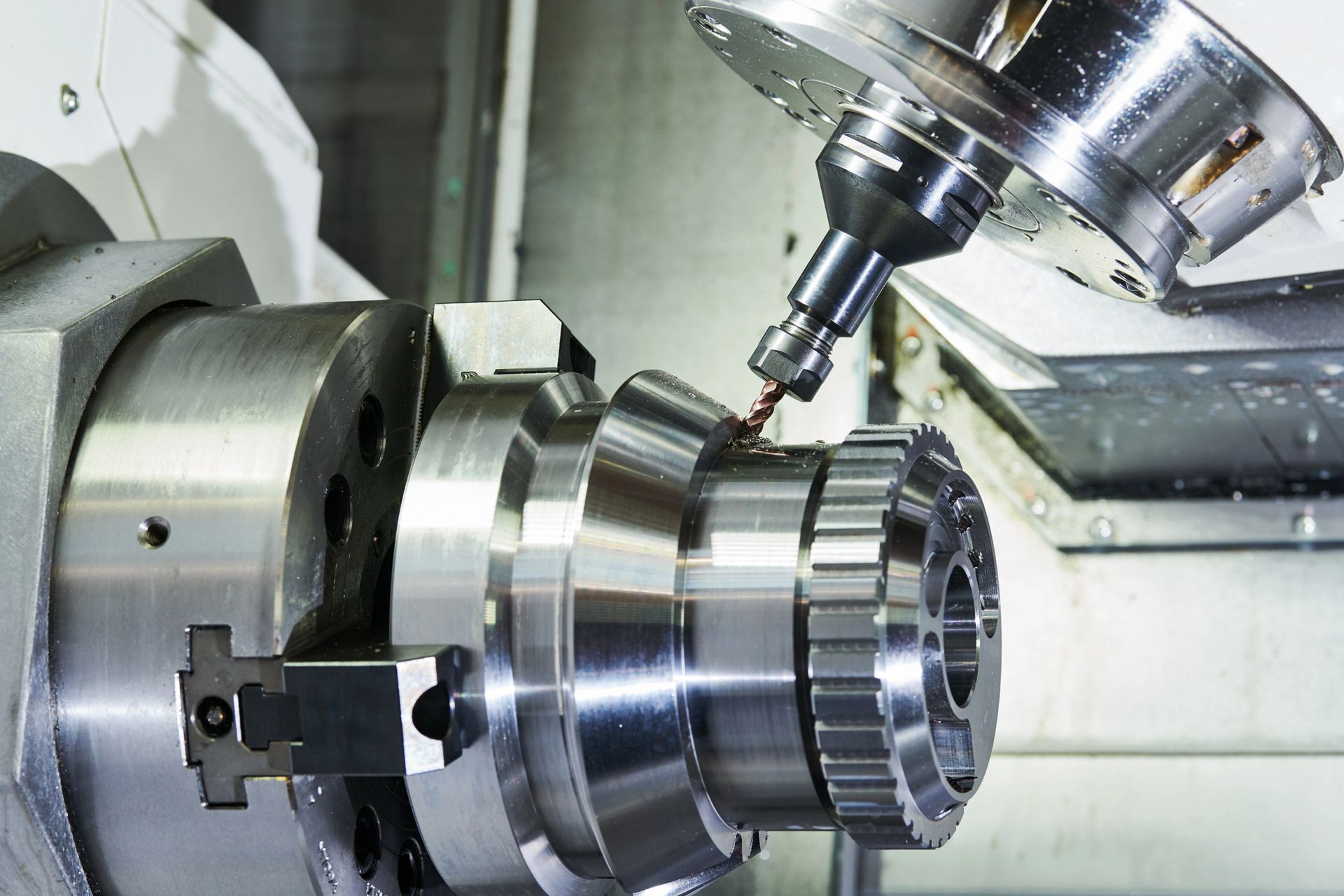Achieving Tight Tolerances and Superior Surface Finish in CNC Machining
In high-precision manufacturing, success often comes down to microns. Every component that rolls off a CNC machine must meet exacting specifications, not just in size, but also in surface quality.
As demand increases for parts with high-precision tolerances across industries like aerospace and medical, the ability to maintain tight specs and consistent finishes is no longer optional. These requirements influence product quality and affect functionality, safety, customer satisfaction, and your bottom line.
Keep reading to learn how tolerances are defined, what impacts them, how to manage surface finish in CNC machining, and why metrology and inspection practices are essential for long-term success.

The Basics of Tolerances
A tolerance is the permissible deviation from a part’s nominal dimension. In practical terms, it’s the range a measurement can fall within and still be considered acceptable. For example, a shaft specified as 10.00 mm ± 0.02 mm must measure between 9.98 mm and 10.02 mm.
Common Types of Tolerances
Depending on the part's design intent and functional requirements, you can apply tolerances in several ways. Here are some of the most widely used types:
- Bilateral tolerance: Allows variation in both directions (ex: ±0.01 mm).
- Unilateral tolerance: Permits variation in only one direction (ex: +0.00/-0.02 mm).
- Geometric dimensioning & tolerancing (GD&T): Defines part geometry and allowable variations using a symbolic language.
The basics of GD&T are dimensions, form, orientation, and position. A closer look reveals how they allow for more complex and functional part tolerances that still fit together perfectly during assembly.
Industry Standards Matter
Designers don’t randomly choose tolerances; International standards such as ISO and ASME assign them. These guidelines ensure that parts manufactured on one continent will function as expected when assembled on another, an essential aspect of global production.
Factors Affecting Tolerances
Even with clearly defined specs, the real-world ability to meet them depends on several interacting factors:
Machine Capability
Spindle accuracy, repeatability, and backlash all influence the machine’s ability to stay within high-precision tolerances. Even if the program is flawless, machines worn from heavy use or improper maintenance will introduce variation.
Tool Selection and Wear
Tool geometry, coating, and material (such as carbide or HSS) influence surface quality and dimensional accuracy. As tools wear, they can oversize or undersize features and degrade surface finish, affecting tolerances and part life.
Material Properties
Material characteristics like thermal expansion, hardness, and elasticity all impact how a workpiece behaves during machining. For example, aluminum expands significantly more than steel under heat, which can alter final part dimensions if not accounted for.
Softer materials may deflect or vibrate more under tool pressure, while harder ones might cause tool wear or heat buildup. Understanding these properties allows machinists to fine-tune feeds, speeds, and tool paths to maintain tolerances and surface finish.
Environmental Conditions
Shop temperature, humidity, and vibration can introduce variability. Even slight temperature fluctuations can cause materials to expand or contract, making it harder to maintain accurate CNC measurements.
Surface Finish Fundamentals
While dimensional tolerances often get the spotlight, surface finish is equally critical, especially in industries where sealing, friction, or visual aesthetics matter.
What Is Surface Finish?
Machinists usually describe surface finish using roughness values such as:
- Ra (Roughness Average): Average deviation from the mean line across a surface
- Rz: Measures peak-to-valley height within a sampling length
A smoother finish means lower Ra and Rz values, which can improve performance in high-speed or high-pressure environments.
Why Surface Finish Matters
A part’s surface finish can significantly impact its performance, longevity, and functional requirements:
- Friction and wear: Poor surface finish can increase resistance between moving parts, leading to faster degradation or failure
- Sealing surfaces: If the surface is too rough, O-rings and gaskets may not seal properly, causing leaks or pressure loss
- Appearance: High-end components often require smooth, uniform finishes to meet visual and branding expectations
Surface Finish Methods
Each machining technique impacts surface quality differently:
- Milling: Can leave visible tool paths if not optimized
- Grinding: Produces finer finishes, but is slower
- Polishing: Often used for aesthetic or ultra-smooth surfaces
Your chosen method should align with the part’s functional and visual requirements.
Techniques to Improve Surface Finish and Tolerances
Tight specs and smooth finishes come from smart setups, precise techniques, and well-maintained tools. These strategies are essential for improving CNC quality in high-demand production environments.
Optimized Tool Paths
Modern CAM software can calculate tool paths that reduce directional changes, overlap, and tool deflection, common causes of poor surface finish and dimension drift.
Cutting Parameters
Fine-tuning feed rate, spindle speed, and depth of cut can reduce vibrations and tool marks. Lighter passes and slower feeds are typically more effective for tight tolerances and better surface finishes.
Coolant and Lubrication
Coolants keep the tool cool, flush away chips, and reduce tool wear. Choosing the proper coolant system helps prevent heat buildup that leads to out-of-tolerance parts.
Tool Material and Coatings
Carbide tools with PVD or CVD coatings hold sharpness longer and reduce friction, helping to maintain consistent surface finishes and high-precision tolerances over longer runs.
Machine Maintenance
Misalignment and wear can sabotage even the best programs. Routine calibration, lubrication, and mechanical checks ensure your equipment stays ready to hit the tightest specs.
Inspection and Metrology
Manufacturing to spec is only half the battle. The other half is proving it accurately and consistently:
- Coordinate Measuring Machines (CMMs): Excellent for complex geometries and tight specs
- Profilometers: Evaluate surface finish in Ra, Rz, and other metrics
- Micrometres and Dial Indicators: Ideal for quick checks on simple dimensions
These tools are essential for accurate
CNC measurements, especially when tolerances fall below ±0.001 inches.
Quality Assurance Processes
Robust inspection methods at every production stage help provide consistent quality in high-precision tolerances. These checks can catch issues early, reduce waste, and ensure each part meets expectations.
- First-article inspections: Ensure the first part meets all design specs
- In-process checks: Reduce scrap by identifying errors early
- Final verification: Confirms part quality before it ships
Data Logging
Modern QA software lets teams monitor process drift over time, linking to specific tools, machines, or conditions. Many shops use software to record and monitor dimensional trends:
- Tolerance drift analysis: Identifies when a tool or machine needs recalibration
- Traceability reports: Beneficial for certifications, audits, and continuous improvement
Case Studies and Applications
Real-world success often comes from combining good strategy with the right tools and conditions.
- Aerospace brackets: Clearwater Engineering, an aerospace supplier based in Kansas, achieved a 45% reduction in scrap rates by implementing TDM Systems' tool data management software. This improvement was attributed to better tool holder selection and accurate tool setup, leading to significant savings in setup time and tool usage.
- Medical implants: A leading medical device manufacturer used CNC machining to make titanium alloy orthopedic hip and knee implants. The CNC process allowed the components to have tolerances as tight as ±0.02 mm, ensuring perfect alignment and functionality.
Each example demonstrates how improving tolerance and finish quality can reduce rework and waste, and elevate product performance.
From Tolerances to Finishes: GN Helps You Nail It
Controlling dimensional tolerances and surface finish in CNC machining is necessary for shops that want to stay competitive. Whether you're creating critical parts for aerospace, complex components for medical devices, or looking to reduce scrap and rework, GN is here for you.
GN helps you fine-tune your setup with the proper tooling, advice, and equipment to achieve accurate measurements, tight tolerances, and better surface finishes, so you get better results with less rework.






